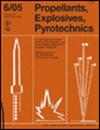A model for the combustion behavior of AP/HTPB propellant containing ultrafine aluminum
IF 1.7
4区 工程技术
Q3 CHEMISTRY, APPLIED
引用次数: 0
Abstract
Nano‐aluminum, renowned for its remarkable efficacy in augmenting propulsion efficiency and regressive velocity, stands out as a compelling choice for incorporation into heterogeneous propellant compositions. Nevertheless, the considerable expense of this ultrafine aluminum variant, coupled with the inherent hazards associated with conducting propellant trials, may deter extensive allocation of resources and efforts towards the intricate processes of amalgamation, molding, and comprehensive analysis of the combustion characteristics of freshly devised propellant blends. To provide theoretical support for predicting the chemical properties of nano‐Al composite propellant, we establish a numerical framework to study the combustion characteristics under the working environment of a solid rocket motor. A new five‐step kinetic mechanism is developed in this model to describe the reaction process in the gas phase while accounting for heat conduction, radiative effects, and non‐planar moving surfaces. The comparison between our theoretical work and experimental results confirms that making no distinction among Al particle sizes below 3 μm is reasonable. Finally, the effects of nano‐Al on combustion, burning rate variation, and temperature sensitivity are analyzed in detail.含超细铝的 AP/HTPB 推进剂燃烧行为模型
纳米铝因其在提高推进效率和后退速度方面的显著功效而闻名,是将其纳入异质推进剂成分的一个引人注目的选择。然而,这种超细铝变体的费用相当可观,再加上进行推进剂试验的固有危险,可能会阻碍将大量资源和精力用于混合、成型和全面分析新设计的推进剂混合物的燃烧特性等复杂过程。为了给预测纳米铝复合推进剂的化学特性提供理论支持,我们建立了一个数值框架来研究固体火箭发动机工作环境下的燃烧特性。该模型建立了一个新的五步动力学机制,用于描述气相中的反应过程,同时考虑了热传导、辐射效应和非平面运动表面。我们的理论工作与实验结果的比较证实,不区分 3 μm 以下的铝颗粒大小是合理的。最后,我们详细分析了纳米铝对燃烧、燃烧速率变化和温度敏感性的影响。
本文章由计算机程序翻译,如有差异,请以英文原文为准。
求助全文
约1分钟内获得全文
求助全文
来源期刊

Propellants, Explosives, Pyrotechnics
工程技术-工程:化工
CiteScore
4.20
自引率
16.70%
发文量
235
审稿时长
2.7 months
期刊介绍:
Propellants, Explosives, Pyrotechnics (PEP) is an international, peer-reviewed journal containing Full Papers, Short Communications, critical Reviews, as well as details of forthcoming meetings and book reviews concerned with the research, development and production in relation to propellants, explosives, and pyrotechnics for all applications. Being the official journal of the International Pyrotechnics Society, PEP is a vital medium and the state-of-the-art forum for the exchange of science and technology in energetic materials. PEP is published 12 times a year.
PEP is devoted to advancing the science, technology and engineering elements in the storage and manipulation of chemical energy, specifically in propellants, explosives and pyrotechnics. Articles should provide scientific context, articulate impact, and be generally applicable to the energetic materials and wider scientific community. PEP is not a defense journal and does not feature the weaponization of materials and related systems or include information that would aid in the development or utilization of improvised explosive systems, e.g., synthesis routes to terrorist explosives.
 求助内容:
求助内容: 应助结果提醒方式:
应助结果提醒方式:


